Il fait froid
[moving identity 3]
Leslie Huppert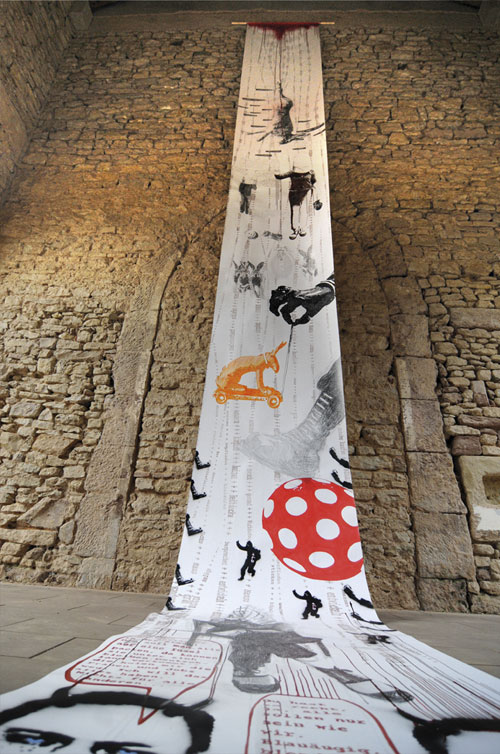
Leslie Huppert's latest work is an impulse of contemporary art on a pressing, socio-political issue: people on the run. The work was shown for the first time at the cultural site Wintringer Chapel and is the starting point for a cooperation with the Kulturzentrum am Eurobahnhof in Saarbrücken. In 2016, a continuing exhibition will take place there in dialogue with other artists together with a public discourse.
Flyer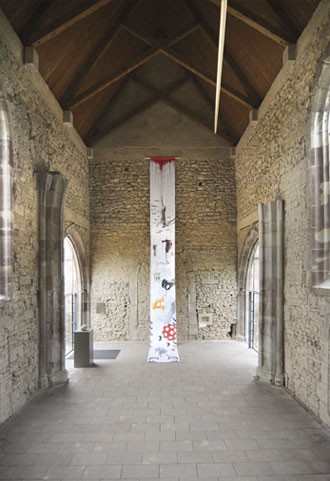
Under the title "Il fait froid", Leslie Huppert has painted a roll of paper about 10 meters long, which can be seen in the central axis of the west wall in front of the bricked-up portal. The scroll evokes the early way of recording and transmitting significant messages on scrolls of scripture.
The chosen form of presentation and its subtle, scenic sequences have an unusual suggestive power, polarize in space, order time, turn protected affluent life upside down, disturb, make you think, demand action - solidarize!
The dimensioning and position of the paper roll directly opposite the broken wheat stalk, with the leaf hanging by a "silken thread" (The Limits to Growth, Hermann Bigelmayr 2011) is deliberately chosen: The border has been crossed! Thousands die on the flight to the saving model house Europe. Those who make it, the will to survive threatens to freeze. How things will continue remains up in the air.
Il fait froid - it's getting cold, is the logical title of Leslie Huppert's film, which presents the viewer with a strip of reality in an unvarnished visual language. The role seems like a concentrated cut to a global reality that Western European affluent countries have long suppressed: for the first time since World War II, more than 50 million people are fleeing violence and hardship. People traumatized by the bloody wars in Somalia, Iraq or Afghanistan who have made their way to Europe will not only feel cold because winter is coming to Europe. They will also feel cold when their longings are shattered by barriers and fences. People can only become warm in the sense of being valued and feeling safe where they can find a dignified place to stay and are welcome.
Eat... doubt... walk... struggle... memory... Vision..., these are just some of the flashes of thought that make their way across the images like endless telegrams across paper. Thoughts of escaping people who want to sound out a future behind an impenetrable fog. It almost seems as if Leslie Huppert has received the refugees' world of thoughts like a medium in order to give them voice via her scroll of images. It is a language of inner images that have to push their way out, covered with flowing textures - convincingly unambiguous at the latest at second glance - and that even for those who perhaps do not want to understand or read in the first place, who would prefer to look away.
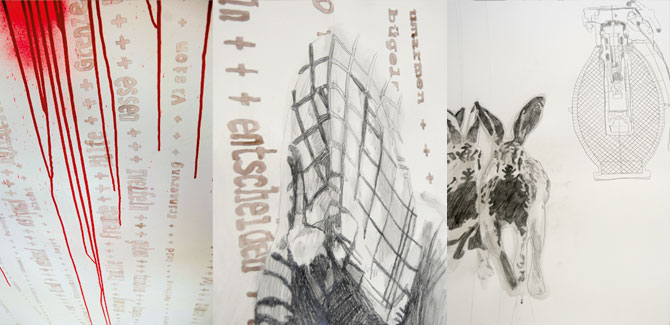
It is those mills of thought and images that turn incessantly in the heads of the displaced persons and simply cannot be turned off that Leslie Huppert has meticulously captured on paper over a period of weeks with fine drawings and textures, sometimes colored or washed out. They arouse dizziness in fleeing people - by constantly hooking them - make them stagger, make them defenseless. Like an endless loop, the scraps of words seem to jump from the lower edge of the picture back up to the starting point of the image. The artist deliberately sets the course of the chain of images upwards, to the origin of flight - once the cultural root and home of the refugees.
If one lets one's gaze roam over the scenario from above, one gets the impression that the bloodstains of countless victims and a constant crossfire from the rifles and grenades are driving the imaginary collective of refugees and their distressed thoughts in front of them like startled rabbits in order to bring them down. Without fear of death, no one flees unprotected across open fields, leaving their own biography hanging in the cover. A toy rabbit on wheels, to be dragged behind, symbolizes the children and young people who escape from the hopelessness of their childhood homes in the tow of their parents, sometimes all alone, and arrive traumatized in an increasingly overtaxed Europe. In view of the large number of refugees, the individual fates are all too easily lost in the confusing in-between worlds of flight.
The sequence of images therefore logically presses downward into the depths, into the unknown, and incessantly poses questions: Does the dream of a better life end in Europe, at the fences of a fortress? And how is the experience to be overcome at the supposed destination of longing, when the unforeseeable dangers of flight, hunger, humiliation and violence have burned themselves indelibly into the souls of the refugees?
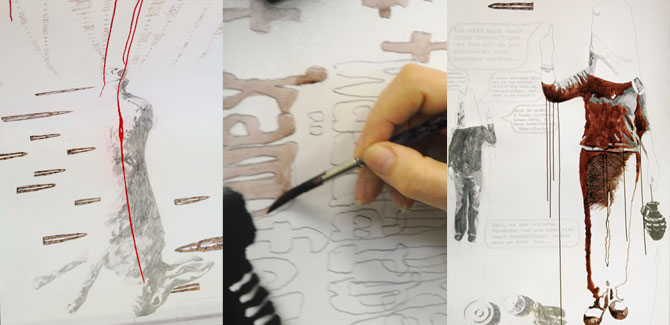
What awaits those who have struggled to get by when they reach the refugee camps in the towns and villages? A trellis of xenophobia, fed by the fear of falling short? Where does the ball roll - the beloved toy - here, however, rather as a symbol of the footfalls of right-wing boots and the wandering through the bureaucratic systems of Europe - partly under inhumane conditions, without prospects?
If there were not a glimmer of hope, nourished by Europeans' memories of their own stories of flight, expulsion and evacuation. Germany is even more aware today of its own wave of expulsions, which began in 1933, than perhaps it was then!
If it were not for the view of Christians, who know refugee movements from their basic religious experiences of the Exodus narratives (exodus from Egypt to the Promised Land) from childhood and can apply it in the present to improve tolerance and fellow humanity.
Leslie Huppert takes a stand, puts herself in the picture, towards the end of the film with a newspaper bag as a camouflage cap on her head, and asks: Despite all the knowledge, what still blocks the view of the perspective of an immigration society that sees its potential, both ethical and economic? Is it the fear of losing one's own identity in this mixed situation? Is it the fear of losing one's own identity in the mishmash? Does it clear the view of a new guiding culture, which cleans the view of the chances of the encounter of cultures in openness, tolerance and mutual assistance, it seems to read under the "cloak of invisibility" between the lines of the newspaper.
Finally, the "Gehörnten" let the cold shiver from the right run down your spine once again...
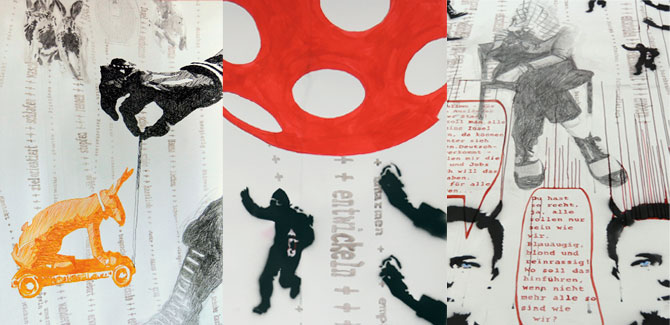
Questions stand in the late Gothic space of the Wintringer Chapel, which in the 16th century was itself the scene of war and flight and finally desolation, and makes this cold shiver as an echo in the walls retrievable for all who can hear it: Must always the disaster force us to think and act anew? What remains to be done ... what scope for action and design does each individual have? How can a balance be struck between cultural self-determination and integration? What framework conditions does politics provide so that such an encounter of cultures can gain ground and grow over time? Are there models for a humane refugee policy that does not overburden the host population in our living spaces?
Leslie Huppert's visual language helps us to sort out our thoughts, to take the processes of shaping a new guiding culture into our own hands, to react: Let's get started! It's up to each and every one of us. We can do it! Integration instead of exclusion from the bottom up.
Welcome to Germany! Glad you have arrived!

Leslie Huppert is the winner of the Cultural Award for Art of the Regional Association of Saarbrücken 2014
The artist is distinguished by her conscious artistic exploration of transformation and identity formation processes within our society. For example, through an international call for a virtual migration of peoples, she addressed European transformation processes of recent years in her project "Virtual Residency" and generated a creative migration of ideas, themes, images and motifs. With her contemporary forms of artistic expression, the artist repeatedly succeeds in causing a sensation and advancing current debates on current socially relevant issues. In her works, she combines art forms of conceptual art, multimedia art/media art, painting, photography and drawing to create an artistic "fabric" that polarizes and captivates the viewer. In doing so, she pursues the intention of providing socially relevant commentary and triggering discourse.
Anyone who gets involved in her art projects notices that the artist draws from intense observations. She describes her work herself as an interweaving of communication and cooperation projects generated within the changes through her artistic input.
Excerpt from the vote on the award ceremony
Resume
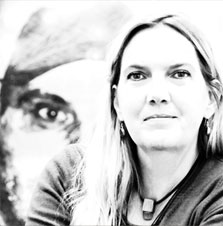
Leslie Huppert
| 1990- | Studies free art at the HBK Saar, painting with Prof. Bodo Baumgarten, new artistic media with Prof. Ulrike Rosenbach and Prof. Jill Scott. |
| 1994 | Studies abroad at the Nova Scotia College of Art & Design (NSCAD), Halifax, Nova Scotia (CA). |
| 1997 | Diploma, master student |
Prizes, scholarships and awards
| 1996 | Network art competition Vision 2000, ZKM, Karlsruhe, honorable mention. |
| 1997 | Art students exhibit - 12th national competition, prize winner Art and Exhibition Hall of the Federal Republic of Germany, Bonn ; Saarland Multimedia Prize, 1st prize; Internet Prize of the Saarbrücken Municipal Utilities, 1st prize; Sponsorship Prize of the City of Saarbrücken. |
| 2000 | CYNETart 2000, Dresden, honorable mention Brainwash; Photo competition of the Rhein-Sieg-Kreis 2000, honorable mention. |
| 2002 | fremde heimat, dna-award, DigitalART Frankfurt/M., 2nd prize connect. |
| 2003/ | Saar-STIP, scholarship of the permanent representation of Saarland at the federal government in Berlin. |
| 2008 | 5th Marl Video Installation Prize Sculpture Museum Glaskasten Marl: Most Accidents Happen at Home (installation concept). |
| 2009 | Residency "Tulipamwe", International Artist Workshop, Okakarara (NA); Residency Artis den Bosch, s'Hertogenbosch (NL). |
| 2010 | Ideenwerkstatt KunstKommunikation, Kunsthaus Kloster Gravenhorst; Art Karavan International, Art Caravan through North India. |
| 2012 | Scholarship of the Kulturstiftung Rhein Neckar Kreis in the Burgfeste Dilsberg. |
| 2013 | Project grant for "Virtual Borders - traveling Lightly" by "Grenswerte" |
| 2013 | Nomination for the Robert Schuman Award |
Art on building projects
| 2013 | In Saarbrücken Prison "The perfect Dream/Room" is a project that was carried out together with 7 inmates. |
| 2014 | A second project, "Balance", was carried out together with 5 other inmates at Saarbrücken Prison. |
Solo exhibitions (selection)
| 1997 | The Robe - a communication sculpture, (installation and internet), Johanneskirche Saarbrücken; Avatar 3, petrified up to the hips (net project), internet gallery of the Stadtwerke Saarbrücken. |
| 1999 | Moving Identity (multimedia installation), Kunsthaus Essen; Municipal gallery Neunkirchen. |
| 2003 | Closed Circuit (Internet and video installation), pizzart.com, project space in Cologne (APC Galerie/u. Galerie art-buvette, Fribourg (CH). |
| 2006 | United I stand (video installation, Saarländische Galerie - Europäisches Kunstforum e.V., Berlin. |
| 2011 | EXPATRIATE - home sweet home, Saarbrücken City Gallery |
Projects and activities (selection)
| 2001 | Gegenort - The Virtual Mine (international media art project former mine Gegenort, Neunkirchen) |
| 2004/ | Virtual Residency - Call for a Virtual Migration to the Model House Europe (international media art project) Handwerkergasse - World Cultural Heritage Site Völklinger Hütte, Völklingen/Faux Mouvement - Centre d'Art contemporain, Metz (FR)/Galleria Bia a, Lublin (PL), in the context of Luxembourg and Greater Region - European Capital of Culture 2007, HBKsaar |
| 2012 | Virtual Borders - traveling lightly (International video installation project at Burgfeste Dilsberg May 2012 and August 2012 at Saarländische Galerie, Europäisches Kunstforum, Am Festungsgraben, Berlin), www.virtual-borders.net |
| 2013/ | Virtual Borders - traveling lightly. In the context of Grenswerte, a video parcours through the Euregio at the German/Dutch border, www.virtual-borders.net |
| 2014 | Cultural Award for Art of the Regional Association Saarbrücken |
Peace Talks
Under the title "Moving Identity" Leslie Huppert has developed variable installations 1999 - 2011, which are made accessible to viewers at various locations.
In this part of the project I deal with the topic of migration, be it through waves of refugees triggered by wars, hunger and poverty or through voluntary migration for economic reasons as well as for motives of personal self-realization.
We are in a time of enormous upheaval, which frightens many people and promotes irresponsibility, greed and inconsideration, as many no longer identify with their surroundings and social environment but essentially think and act for themselves and their children. For me it is a good starting point to deal with questions of one's own ideas, one's own utopian concepts and ideas.
Leslie Huppert
For a current occasion, in addition to the installation "Il fait froid" at the cultural site Wintringer Chapel, "Peace Talks" will be shown, which were recorded as part of this action program of the artist.
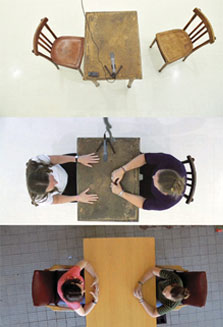
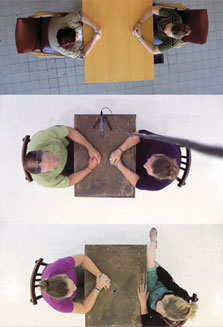
Peace Talks
Random mobile peace-talks
Leslie Huppert
City Gallery Saarbrücken 2011
Project and video installation
Two people are sitting across from each other at a table. One asks questions, the other answers. The simple, almost childishly naïve questions are asked in a very reduced and spontaneous manner and, with their strongly subjective character, lead into the tensions between reality and utopia as well as between feasibility and impossibility.
To questions about peace and war, the responding person reacts with extensive reflections, getting lost in the confusion and complexity of the topic. In the effort to find a solution, only confusion remains at the end of the answer.
The action took place in 2011 in the Stadtgalerie Saarbrücken. The question-and-answer action was carried out with different participants throughout the duration of the exhibition, with the questioner always being the same person. The conversations were filmed from above and projected onto the wall or onto a table in the installation, depending on the room situation.
Peace Talks

